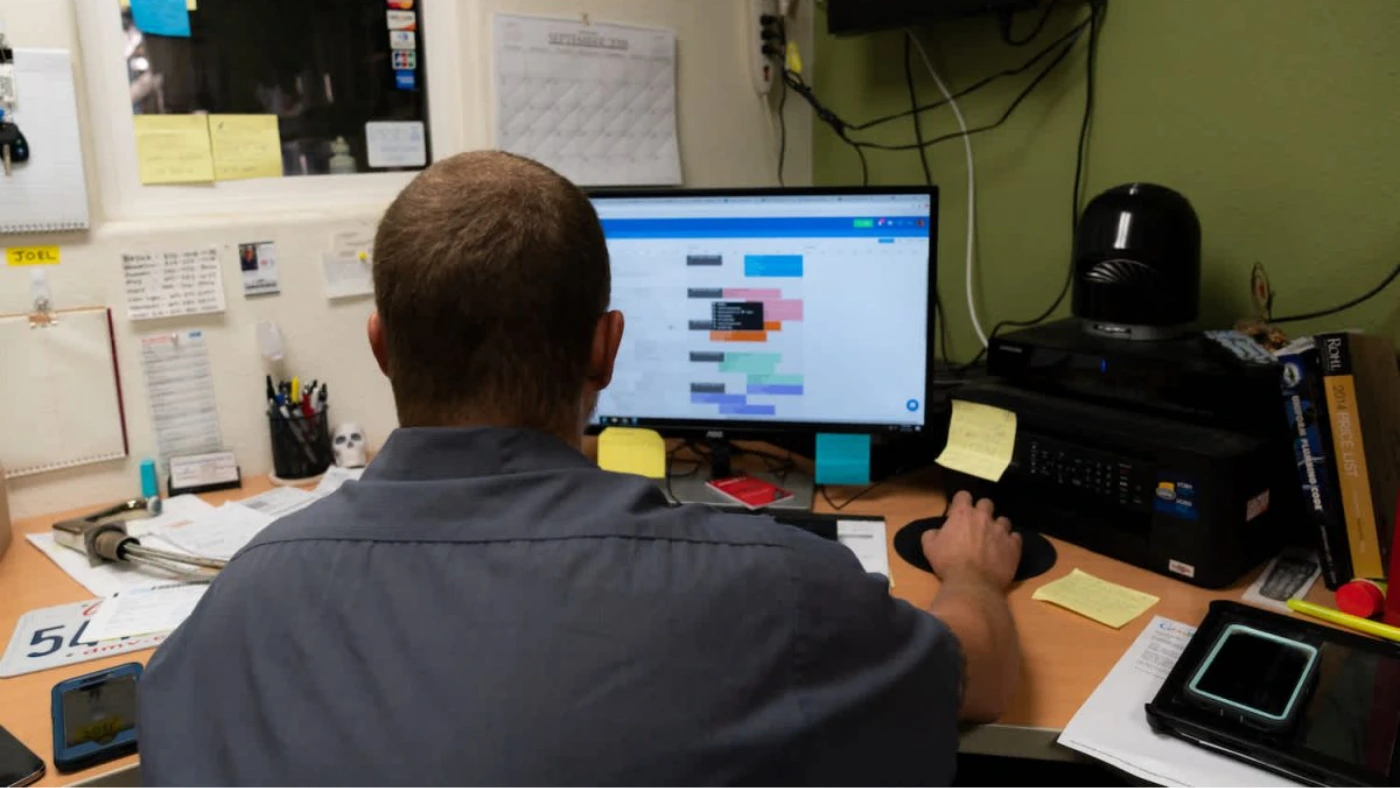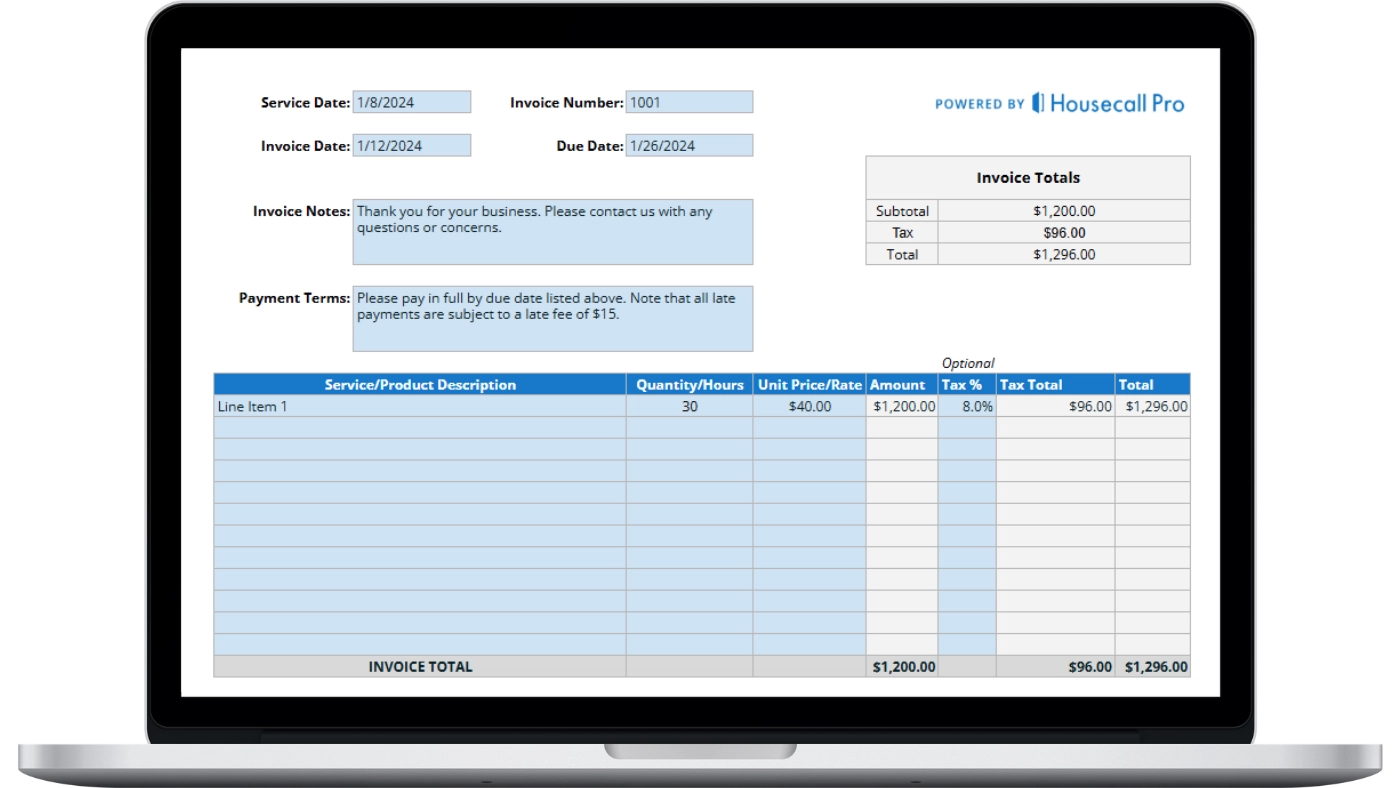
Growing your business means winning more bids, but simply winning jobs isn’t all you need to keep your electrician business afloat. If you improperly calculate your bids, you may see smaller profit margins or even end up with a net loss for some jobs.
Any experienced electrician will tell you there’s an art to crafting the perfect bid, but at Housecall Pro, we’ve nailed it down to a science. Our guide to bidding on electrical jobs can help you fine-tune your bids, hone your estimation skills to bid more accurately on the spot, and ultimately earn more profit.
As we developed our electrician estimate template, we considered all the elements: materials, labor, and overhead, so you can be sure your pricing strategy is profitable. To help you improve your quoting process, we’ve developed our step-by-step guide, so you can start quoting both residential and commercial electrical work properly.
If you like what you read below, check out Housecall Pro’s electrical contractor software and our other solutions for electrician businesses, including streamlining your sales pipeline and online tools to help you manage your business and appointments from the field.
What is an Electrical Estimate?
An electrical estimate is the process electricians use to determine the cost of completing an electrical job and still making a profit. Computing the cost for each job includes considering all materials needed, as well as equipment, subcontractors, labor, and other overhead you incur to complete the job.
Estimating can be tricky – you need to bid low enough to be considered for the client’s budget yet high enough to make a profit. We can make this electrical work pricing process much easier for you, taking the stress and guesswork out of any type of electrical job bid.
How Do You Estimate Electrical Work?
Running your business is different from bidding for jobs; in fact, even Master Electricians still collaborate on larger service or commercial bids. While you could use the “by the hole” method of bidding or other rule-of-thumb practices that you may have learned in the field, you may find that using our step-by-step guide or our estimating software improves your profit margins.
Learning how to do estimates longhand can hone your bidding skills, making it easier to make on-the-spot bids for smaller, less complicated jobs. But while you’re learning how to bid “the long way,” you can also use Housecall Pro’s handy free electrician estimate template, which is flexible enough for even the most complex, multi-phase construction bid.
How to Estimate Electrical Work: Step-by-Step
Want to boost your profit and win more jobs? Follow our step-by-step guide below:
1. Bid on the right jobs
Knowing your capabilities and limitations can make selecting jobs that fit your business easier. Avoid bidding on jobs where you have limited experience. For example, if you specialize in industrial electrical work, then you may not be as familiar with the demands of residential bidding, and vice versa. That’s not to say that you can’t bid on jobs outside your expertise, but if you’re just starting out, you may find it easier to learn to bid on jobs you know and then branch out to other types of jobs.
As your business grows, you’ll have more data to draw upon, making your bids more precise. There can be a steep learning curve when taking on new types of work, so knowing the right jobs to bid on and knowing when to pass can prevent you from getting in over your head and losing money.
2. Evaluate the specs
Thoroughly review all job specifications, paying special attention to the job’s Division 01 general specifications and the more detailed, job-specific Division 26 specs. The Request For Proposal (RFP) or bid request should include:
- Contractor qualifications
- Payment terms
- Bonding capacity
- Insurance requirements
- Warranty period on materials, labor, or both
Do you meet the initial qualifications to place the bid? If you don’t meet these specifications, then you may not be able to live with the legal requirements of the job.
Once you’ve reviewed the general specifications, review the Division 26 specs. These typically include:
- Material grade
- Installation methodologies
- Responsibilities for cost, such as providing fire alarms, communications, etc.
Typically, the specs will indicate the quality of materials the client needs, while the drawings determine the quantities of each type of material. Put these together and you’ll be able to calculate the raw materials cost for the job.
Read the client’s proposal carefully, looking for anything out of the ordinary that could affect your bid, from a short completion deadline to a higher grade of material than is typically used for similar jobs. If you plan to offer alternative options to the required materials (or other changes), be sure to get client approval in writing for the substitution; otherwise, you could be legally held to the standards in the bid and end up with a minimal profit or even a loss.
3. Analyze the drawings
Start by reviewing the drawings at a high level to get an idea of the full scope of the job. Look at the architectural details of the job site or building and the specific electrical drawings. Note working elevations and heights that could affect labor costs, equipment requirements, and materials pricing.
After you’ve gotten a firm grasp of the bird’s eye view of the project, it’s time to delve into the Division 26 specs. Note technical details depicted in the drawings, note any discrepancies between the specs and the drawings or blueprints, and write those down.
4. Perform a quantity takeoff
Ideally, your electrician estimating software can handle electrical takeoffs. If not, prepare for long hours of counting. If you’re doing it manually, there’s a lot of room for human error at this stage, so we recommend doing it twice to ensure accuracy or having someone else complete the process, too, for an independent assessment.
Grab highlighters and your scale master and start counting and measuring:
- Light fixtures
- Conduit runs
- Receptacles
- Panels
- And other gear or fixtures that you need to account for or provide
Our favored approach is to start with one item (we usually begin with light fixtures, but it doesn’t really matter which item you start with) and count each one. Go sheet-by-sheet, totaling the number of each item on the sheet (write the total on each sheet as well as your notepad). Once you’ve finished, return to the beginning and start with items #2, #3, and so forth.
Identify any low-voltage needs and ask your client if you’re responsible for low-voltage or HVAC hookups.
5. Get current supplier pricing
Lighting counts are often quoted independently of the rest of the materials, which is why we usually start our counts with the light fixtures.
Note the designations that your client uses on the plans to identify each fixture (A1, B2, C3, etc.). The lighting firm will reference the lighting schedule on the drawings to look up the details of each fixture and give you a lump sum quote for all the fixtures.
If you’re fortunate to live in an area with multiple lighting firms, it’s usually in your best interest to develop a close business relationship with one or two to ensure you get timely quotes and competitive pricing.
6. Create your estimate
If your estimating program doesn’t have a process for automating this process, be prepared for another long round of manual effort. There’s potential for human error at this stage, so we recommend the same measures—complete the process twice or have someone else complete it and compare totals.
Once you have the quantities of each item you’ll be required to provide; you can move on to costing out the unit price for each item, accounting for both the materials and labor costs. Determine the labor cost for installing each item, plus the materials, then multiply that by the total number of each item.
Arriving at the material cost is fairly simple; you can get this information with a quick call to your vendor, supplier, or a pricing service if you use one. Determining the labor cost for each item is more complicated. It requires you to know how long it takes to install the material or complete the phase. You can draw on your past experience or on data you’ve collected from your team to understand how long certain things take.
Newer electricians with limited field experience, or those without a long production history, will have a more difficult time than electricians with many years of experience and a robust data history to draw upon. The National Electrical Contractors Association’s (NECA) Manual of Labor Units can be a helpful tool for estimating the cost of labor and installation, although you may need to tweak the totals a bit to match the scope of the work and your experience.
Multiply the multiplied labor cost by the labor unit to arrive at the total labor cost for each item. Then, add up the total cost for each item, breaking it out into total materials cost and total labor cost, to get the total cost of materials and labor.
This may not be your final cost for the bid, though. Materials and labor are your highest costs and provide the foundation for your estimate. However, you may need to rent specialized equipment if you don’t own it or may need a subcontractor or two at several different stages of the project. Those costs should also be factored into your total estimate.
Get In Touch: 858-842-5746
Let us earn your trust
On average, Pros increase monthly revenue generated through Housecall Pro by 50% after their first year.
See plan options and feature breakdown on our pricing page.
7. Add overhead & profit
Now that you have your direct cost for the job, it’s time to consider the profit and account for overhead. If you’re a single owner-operator or a smaller electrician business, you may be thinking, “What overhead?”
Even a single contractor has overhead, and you need to account for it in your bids; otherwise, your profit margin suffers. Your overhead is the cost of keeping your business open and includes the cost of an office lease, time spent estimating, sales and marketing initiatives, bookkeeping and tax preparation costs, and other business-related expenses. Without adding in a fraction of your business operating costs into each bid, you’ll see your profits continually shrink.
To determine your overhead cost, tally up your annual overhead, which is the total cost of running your business (excluding materials and labor). Even a single owner-operator without a brick-and-mortar office has overhead, like marketing expenses, truck and gas, internet and phone, and other business-related expenses.
Then, calculate your total overhead as a percentage of your annual sales. For example, if your overhead is $100,000 and your annual sales are $1,000,000, then your overhead rate is 10%. Account for a certain portion of this in your estimate and a fair profit margin to arrive at your total bid cost.
8. Build your proposal
Now that you have your total sale price for the job, it’s time to build your proposal. Your client may have a specific request-for-estimate template that you have to fill out, detailing the cost of materials, labor, and overhead, or you may need to create the proposal yourself.
The proposal should be clear and concise, easy to read, and use similar language to that of the estimate request or the project drawings and specs. This makes it easier for the project’s general contractor to level the bids and evaluate them, making sure that you don’t leave anything out of your quote.
Although most electrical contractors present lump-sum bids for jobs, it’s important to detail your costs, clarifying everything included with the bid and specifying anything excluded in the service you’ll provide. Clearly stating what the client will and will not get in your quoted cost for the job eliminates any confusion or miscommunications once you’ve been awarded the bid.
9. Double-check takeoff quantities & estimate
Even if you use electrical bid creation software to draft your proposals, it’s always best to have a second set of eyes review each bid before submitting it. If you’re bidding on smaller jobs, such as lighter residential tasks, you may not always need a second look, but for larger, more complex jobs, it’s critical to have your estimate reviewed to ensure you didn’t miss anything.
Keeping a bid log of every bid you’ve submitted, both accepted and rejected, provides you with a frame of reference for similar jobs. A simple spreadsheet showing recent, successfully completed projects, with the price-per-square-foot listed for reference, can help you better understand your general costs for certain tasks.
While it’s not recommended to bid on projects based on the per-foot cost of similar jobs (there are just too many variables), keeping track of your general costs and comparing them to current bids can help you identify large changes in pricing. If there is an exceptional delta, you may need to drill down into your operations and figure out why.
10. Submit the bid
Once you’ve checked your work, including ensuring that your proposal complies with the client’s preferred submission method and template, then it’s time to submit the bid. Usually, this will be done electronically. You may have gotten a link to the bidding site, in which you’ll fill in the appropriate fields, or submit your bid via email.
Usually, the RFP’s Division 01 specifications will have instructions for submitting your bid. Be sure to follow these carefully; we’ve heard of situations in which a client rejects bids because they were not submitted in the proper format!
11. Review the results
How did you fare? In the beginning, it can be difficult to determine where your bids compare against those of other electricians. General contractors often choose vendors they’re familiar with or numbers they trust. As a new vendor, the more transparent your bids and the more concrete your numbers are, the more trustworthy you appear to the general contractor when deciding which bid to accept.
It’s not just the raw numbers that win a bid. General contractors may choose a higher bid from electricians they are familiar with or with whom they have worked in the past. Getting to know the general contractors in your area or submitting bids for smaller jobs to get your foot in the door can improve your chances of winning the next bid.
When you lose bids, it’s always a good idea to talk to the General Contractor for the project, asking how your proposal compares to others. Sometimes, they’ll give you the numbers from competitors; other times, they may just give you a general idea of whether you were too high for their budget or too low for comfort.
If it’s a private bid, the general contractor isn’t required to give you this information. For a public bid, they usually are. However, even if the contractor isn’t required to share information, if you ask respectfully and indicate that you’re trying to refine your estimation skills, many will provide feedback you can incorporate to develop more successful bids.
Even if you’re awarded a project, it’s still a good idea to request bid tabs to see if you consistently leave money on the table by bidding too low.
How to Create an Electrical Estimate
If you’ve made it through Step 11 and are thinking, “This sounds like a lot of work!” you’re not wrong—good electrical estimating requires a certain time commitment, and that time commitment increases the more complex the job is. Without an estimating system in place, you may spend just as much time bidding as you do working, and that’s not going to make you much money.
Electrical estimating software provides a much easier (and usually more accurate) tool to complete bids much more quickly than a long-hand manual method. However, understanding the methodology behind completing a proper estimate is still critical to your job.
Once you know the basics, you can customize electrical bidding software programs more easily to your business and costs. Many programs include features like auto-count, bid tracking, and a full material and labor database, so you can simply plug in the cost of the job and arrive at a fair bid.
Use an Electrical Estimate Template
An electrical estimate template makes it simple to generate a bid no matter how complex the specs are—but not every electrical estimate template is created equally. At Housecall Pro, we designed our electrician estimate template with real, working electricians in mind. Our format is highly customizable, so you have everything you need at your fingertips in one dashboard and no “clutter” that you don’t need.
It’s web-based, so you can access your software from the field using a phone, tablet, or tablet, allowing you to create estimates right on the spot. This helps maintain consistency with your bids and boost customer satisfaction—they don’t have to wait for you to return to the office to tally up the cost of the project.
With Housecall Pro, you can:
- Personalize your template by adding your logo, branding, and customer information
- Focus less on paperwork with our electronic system. It’s easy to use: simply fill in the blanks with the right information, and a quote is automatically generated
- Download, print, and share your professional quote
- Create estimates anywhere, anytime, as long as you have an internet connection or data
Use Electrical Estimating Software
Good electrical estimating software, like the program we’ve developed at Housecall Pro, provides on-screen takeoff, estimation, and quoting capabilities in one user-intuitive, web-based platform. Set your company apart from the competition with our professionally branded estimate software using a customizable template. You can create different templates for different types of quotes, including a “good, better, best” option for greater flexibility with pricing.
Our system also includes personalized follow-up reminders for past-due quotes so you can convert a quote to a job more easily.
- Convert estimates to invoices with just a few clicks
- Book more lucrative jobs by providing financing estimates between $500 and $25,000
- Improve your conversion rates with the Pipeline module for automatic follow-up reminders
- Analyze your profitability with real-time job costing and gross profit tracking
Grow Your Business With Accurate Electrical Estimates
The more accurate your electrical estimates are, the more trustworthy you appear in the eyes of your local general contractors. Besides that, the profitability of your business often depends on accurately determining the costs for each job.
Housecall Pro takes the guesswork out of accurately estimating electrical projects, from simple residential needs to more complex commercial construction with multiple phases. Our easy-to-use software seamlessly integrates all facets of your business, from tracking labor costs to materials estimates and even accounting for subcontractors or other vendors in your quote total.
Sign up for our free 14-day trial today to experience how Housecall Pro can help grow your business.
Electrical Estimating Frequently Asked Questions
-
Why is an Electrical Estimate Important?
-
General contractors have a certain budget for their projects. Knowing how much an electrical job costs allows them to better select their electrician subcontractors and remain on budget for their customers. Your estimate covers the cost of this phase of the project and makes it simpler for a contractor to approve your bid.
-
How Do You Bid Electrical Work?
-
Bidding electrical work involves determining the cost of materials, labor, and business overhead, plus adding in a profit margin. The more intimately familiar you are with these costs and the better able you are to quantify the cost of an electrical job, the more accurate your quotes will be.
You can manually calculate the cost of your work using the specs provided by the client or use an electrician estimate software program to save time and money (plus significantly reduce errors!).
-
How Should I Price Electrical Work?
-
Price your bids high enough to cover your costs and turn a profit but not so high that you’ve priced yourself out of the competition. Costs vary from region to region, and from project type to project type, which you also need to consider.
Pricing electrical work depends on multiple factors, but with the help of Housecall Pro’s electrical pricing guide, you can more accurately bid work based on your location, the scope of the project, and the materials involved.
-
Why Should I Use an Electrical Estimate Template?
-
The more accurate your quotes are, the better you can manage the business of your electrical company. Electrical estimate templates provide a professional-looking quote that’s easy for a contractor to read. All pertinent information is on one sheet, broken out by line item, and summarized.
-
Why Should I Use Electrical Estimating Software?
-
Eliminating human error in the electrical quoting process saves you a lot of time and money. Electrical estimating software performs all the longhand calculations for you. Simply enter your information once into your customized database, then plug in what you need for each quote. It’s simple, straightforward, and easy to modify if the terms of the project change.






